Summer Food – Kūmara
Te Puna
Atua: Pani Tinaku.
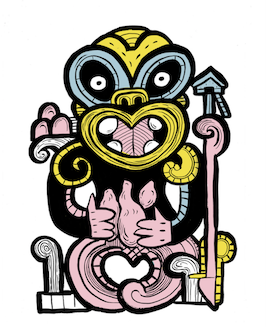
Whakapapa
Te whakapapa o Pani Tinaku.
Pani Tinaku - Whakapapa (PDF, 36 KB)
Pūrākau
Tūmatauenga rāua ko Rongomaraeroa
A Tūmatauenga rāua ko Rongomaraeroa (PDF, 37 KB)
Waiata
Pōpō
Composed by Enoka Te Pakaru, Te Aitanga-a-Māhaki.
http://hana.co.nz/online/ko-wai/
Karakia
Maie te Tupua
A karakia from Waikato for lifting kūmara crops[1].
"Maie te tupua, maie te taniwha
I haere mai koe i whea?
I a Whakaotinuku, i a Whakaotirangi
Ko tō manawa, ko taku manawa
E Tāne ka irihia
Whanowhano, haramai te toki
Haumi e!
Hui e!
Taiki e!"
Whakataukī
Iti noa ana, he pito mata.
He Atua! He Kōrero!
Pani Tinaku
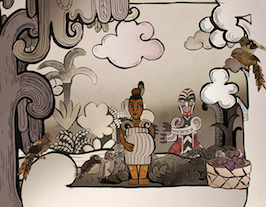
Te Ara has a wealth of information on Pani and her progeny, the kūmara, in both English and Māori.
http://www.teara.govt.nz/mi/kūmara/page-1
- Students work in pairs to find 3 interesting facts about kūmara from the website and present back to the class.
- Using the facts, create a class profile of Pani and the kūmara. This could be an audio profile or fact book including gathered images and information.
Tūmatauenga rāua ko Rongomaraeroa
What you need
- Copies of A Tūmatauenga rāua ko Rongomaraeroa-raupapatia.pdf, cut into strips (1 set per pair)
- Copy of the story A Tūmatauenga rāua ko Rongomaraeroa.pdf
A Tūmatauenga rāua ko Rongomaraeroa (PDF, 37 KB)
What you do
-
Introduce the pūrākau A Tūmatauenga rāua ko Rongomaraeroa. Explain that this story is an origin story – it explains how something in our world originated.
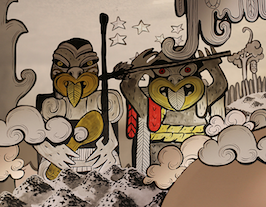
- First read the story to the class. Discuss the story as a class. Ask:
– What is this pūrākau about?
– What does it describe the origins of? (E.g. first taiaha; kūmara; karakia and ritual about the kūmara.)
- Students work in pairs. Each pair has a set of story strips, which they need to sequence correctly. Take turns to read through the story.
- Then pairs read the story, talking turns to read aloud.
- Organise the class into 5 groups. Each group gets a section of the story (story strip). Groups then work together to create a short play for their section. Set a time limit. Perform the plays in sequence.
Pōpō
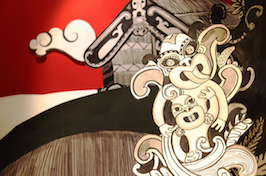
Ko Wai is a teacher’s resource based on four tribal anthems, including Enoka Te Pakaru’s iconic Pōpō!
The oriori is produced in audio visual format which you can share with students and the support material is organised by levels.
Explore the resource here:
http://hana.co.nz/online/ko-wai/
Ako ā-Kākā
Rote learn the first three stanzas of Pōpō!
Maie te Tupua
Ako ā-Kākā
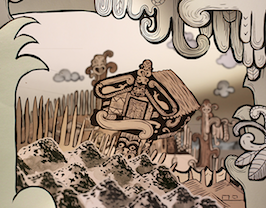
Learn the karakia Maie te Tupua. This can be recited when planting and harvesting, and as a karakia to the gods, in general. It can also be used as a tauparapara, or to begin and end any type of hui.
Iti noa ana, he pito mata
A small tuber can be used as a seed kūmara, to sprout and produce many more kūmara next planting season. This whakataukī refers to the wisdom in making a small investment now in the hope of plentiful return in the future.
- Ask students to prepare a short speech (no more than 500 words) on the potential of investment with the hope of reaping benefits. This could be:
– a monetary investment
– a physical one e.g. training every morning to get into a sports team
– learning something new
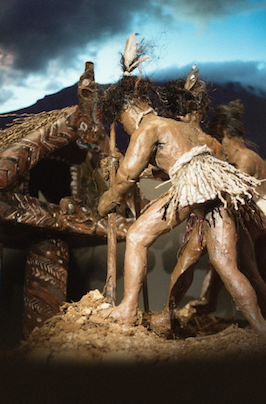
– a new friendship.
- Remind students to include the whakataukī in the speech. Students present their speeches to the class or in small groups.
Possible Assessment Opportunities
Students can:
- Research online, discuss and collaborate on a profile of Pani and the kūmara
- Understand the purpose of pūrākau whakamārama through the story Tūmatauenga rāua ko Rongomaraeroa.
- Retell the story of Tūmatauenga rāua ko Rongomaraeroa in their own words.
- Collaborate with peers to perform a mini play based on a section of the story of Tū and Rongo.
- Recite karakia and use at appropriate times.
- Speak persuasively on the topic of potential.
- Use whakataukī to lead a discussion, emphasise a point or sum up an argument.
Delicious Kūmara
Sprouting Kūmara
Sprout some kūmara in the class, and see how far they grow and creep. Create and experiment and see if growth rate differs when growing kūmara in different liquids.
Visit Kaipara Kūmara’s website:
https://www.kumara.co.nz/general-1-1
What you need
-
Kūmara (one per student)
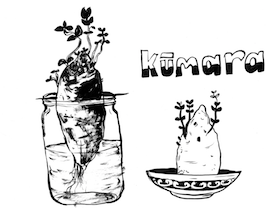
- Glass jar (one per student)
- Toothpicks
- Water, carbonated water, sea or salt water, soda (e.g. coke, fanta)
What you do
- Students work in groups of four. Put four toothpicks around each kūmara.
- Place the kūmara into the jars.
- Each group uses each of the four different liquids and fills their jars to about half way (water, carbonated water, salt water, soda). Make sure the bottom of the kūmara are sitting in about 1.5–2 cm of liquid.
- Put it on a windowsill. Keep the liquids topped up – don’t let them dry out.
- Record observations on a chart:
– measuring growth
– sketching or photographing plant
– comment on appearance
– where the kūmara was situated for the period e.g. windowsill; part shade; all day sun.
- Groups make weekly oral reports to the class based on their observations.
- Students could add another variable – light. Do plants need light to grow? Try putting kūmara in light deprived situations and record results.
Note
Roroi
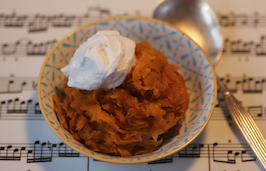
Roroi is the original Māori dessert! Make it with freshly harvested kūmara – the fresher the better.
This recipe suggests adding sugar, although if your kūmara are sweet enough you won’t need it – our tūpuna didn’t!
What you need
- 3 large kūmara
- ¼ cup sugar (optional)
- butter or oil for greasing the dish
- sharp knife
- grater
- small baking dish
What you do
- Heat the oven to 180 ˚C.
- Grease the baking dish.
- Wash the kūmara.
- Grate 2 kūmara – this is called roroi.
- Put the roroi into the baking dish.
- Sprinkle the sugar over the top if you are using it.
- Thinly slice the remaining kūmara and layer them on top of the roroi. This will help keep the roroi moist.
- Bake for 1 hour; checking after 45 minutes.
- Serve with yoghurt, fruit, ice cream or cream. Slice it and eat it cold.
Note
This book contains a number of recipes for kūmara:
Te Kūmara – kātahi nā te kai reka! (item number 11024).
Possible Assessment Opportunities
Students can:
- Set up the conditions for a kūmara growing experiment over several weeks; observe, monitor and report on results.
- Prepare, cook and serve a traditional Māori dish – roroi.
[1] Māori Agriculture, Best. E.
http://nzetc.victoria.ac.nz/tm/scholarly/tei-BesAgri-t1-body-d4-d11.html
